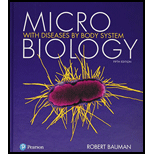
Microbiology with Diseases by Body System (5th Edition)
5th Edition
ISBN: 9780134477206
Author: Robert W. Bauman Ph.D.
Publisher: PEARSON
expand_more
expand_more
format_list_bulleted
Concept explainers
Question
Chapter 1, Problem 2MC
Summary Introduction
Introduction:
The study of microbes or small living things is referred to as
Expert Solution & Answer
Want to see the full answer?
Check out a sample textbook solution
Students have asked these similar questions
In a new batch of culture medium, a group of sub-lethally wounded bacterial cells were transferred. Determine which stage of bacterial growth it will be in?
a. Lag Phase
b. Log Phase
c. Stationary Phase
d. Death Phase
On what basis were both Shigella and Salmonella eliminated aspossible causes of the outbreak pathogen?a. Gram reaction
b. fermentation of glucose
c. oxidase results
d. motility
Choose the combination of answers that most accurately completes the statement.Microbial control methods that kill are able to sterilize. a. viruses c. endospores b. the tubercle bacillus d. cysts
Chapter 1 Solutions
Microbiology with Diseases by Body System (5th Edition)
Ch. 1 - Some people consider Leeuwenhoek the Father of...Ch. 1 - Prob. 1CCSCh. 1 - Some people consider Pasteur or Koch to be the...Ch. 1 - Variant Creutzfeldt-Jakob Disease Ellen screamed...Ch. 1 - Prob. 3TMWCh. 1 - Which of the following microorganisms are not...Ch. 1 - Prob. 2MCCh. 1 - In which habitat would you most likely find...Ch. 1 - Of the following scientists, who first promulgated...Ch. 1 - Which of the following scientists hypothesized...
Ch. 1 - Prob. 6MCCh. 1 - Prob. 7MCCh. 1 - Prob. 8MCCh. 1 - A scientist who studies the role of microorganisms...Ch. 1 - The laboratory of Robert Koch contributed which of...Ch. 1 - Fill in the Blanks 1. Environmental microbiology...Ch. 1 - Prob. 2FIBCh. 1 - Fill in the Blanks 3. Chemotherapy _______________Ch. 1 - Fill in the Blanks 4. Immunology _______________Ch. 1 - Fill in the Blanks 5. Infection control...Ch. 1 - Fill in the Blanks 6. Etiology _______________Ch. 1 - Fill in the Blanks 7. Epidemiology _______________Ch. 1 - Fill in the Blanks 8. Biotechnology...Ch. 1 - Fill in the Blanks 9. Food microbiology...Ch. 1 - Why was the theory of spontaneous generation a...Ch. 1 - Discuss the significant difference between the...Ch. 1 - List six types of microorganisms.Ch. 1 - Defend this statement: The investigations of...Ch. 1 - Why would a macroscopic tapeworm be studied in...Ch. 1 - Describe what has been called the Golden Age of...Ch. 1 - List four major questions that drive...Ch. 1 - Refer to the four steps in the scientific method...Ch. 1 - Prob. 9SACh. 1 - What does the term HAI (nosocomial infection) have...Ch. 1 - Match each of the following descriptions with the...Ch. 1 - Prob. 1VICh. 1 - Show where microbes ended up in Pasteurs...Ch. 1 - If Robert Koch had become interested in a viral...Ch. 1 - In 1911, the Polish scientist Casimir Funk...Ch. 1 - Haemophilus influenzae does not cause flu, but it...Ch. 1 - Just before winter break in early December, your...Ch. 1 - Design an experiment to prove that microbes do not...Ch. 1 - Prob. 6CTCh. 1 - Compare and contrast the investigations of Redi,...Ch. 1 - If you were a career counselor directing a student...Ch. 1 - A few bacteria produce disease because they derive...Ch. 1 - How might the debate over spontaneous generation...Ch. 1 - French microbiologists, led by Pasteur, tried to...Ch. 1 - Why arent Kochs postulates always useful in...Ch. 1 - Albert Kluyver said, From elephant to ......Ch. 1 - The ability of farmers around the world to produce...Ch. 1 - Using the following terms, fill in the following...
Knowledge Booster
Learn more about
Need a deep-dive on the concept behind this application? Look no further. Learn more about this topic, biology and related others by exploring similar questions and additional content below.Similar questions
- The presence of what organism is sometimes used as an indicator that there is sewage present in the water? a. Escherichia coli or E. coli b. Pseudomonus c. Amoeba d. protozoaarrow_forwardWhich bacterial structure is found internally in the cell? a. plasmid b. cell wall c. flagellum d. capsule e. pilusarrow_forwardWhy are endospore vials used to test autoclave function? A. they change color when killed B. they are very resistant life forms C. they are sensitive to pressure changesarrow_forward
- Which phylum contains bacteria with a gram-positive cell wall?a. Proteobacteria c. Firmicutesb. Chlorobi d. Spirochetesarrow_forwardBacteria that derive their carbon from carbon dioxide and their energy from the oxidation of inorganic ions are termed what? a. chemolithotrophs b. chemoorganotrophs c. photoautotrophs d. photoheterotrophsarrow_forwardWhat part of an animal USUALLY do not have microbes? A. Teeth B.Genitalia C. Lungs D. Gastrointestinal tractarrow_forward
- A person in England arrives at a medical clinic with a fever and swollen lymph nodes shortly after returning from a visit to New Mexico. For which bacteria should the doctor test the patient? a. Salmonella enterica b. Borrelia burgdorferi c. Clostridium botulinum d. Yersinia pestisarrow_forwardWhich microbe is NOT found present in water with eutrophication events(s)? A. Nitromonas sp. B. Bacteroides sp. C. Anabaena sp. D. Cyanobacteriaarrow_forwardWhich parasitic protist evades the host immune system by altering its surface proteins with each generation? a. Paramecium caudatum b. Trypanosoma brucei c. Plasmodium falciparum d. Phytophthora infestansarrow_forward
- What is/are the usual habitat(s) of endospore-forming bacteria that are agents of disease? a. the intestine of animals c. water b. dust and soil d. foodsarrow_forwardYou obtain this culture from someone’s mouth. What would you guess that they have? A. filamentous fungi, Candida albicans B. yeast, Candida albicans C. filamentous fungi, Aspergillus D. yeast, Aspergillusarrow_forwardThe bacteria capable of producing dormant bodies devoid of active metabolism, but carry all the genetic material in the vegetative form. a. Pseudomonas and Campylobacter b. Clostridium and Bacillus C. Mycoplasma and Chlamydia d. Streptococcus and Vibrioarrow_forward
arrow_back_ios
SEE MORE QUESTIONS
arrow_forward_ios
Recommended textbooks for you
- Essentials Health Info Management Principles/Prac...Health & NutritionISBN:9780357191651Author:BowiePublisher:Cengage

Essentials Health Info Management Principles/Prac...
Health & Nutrition
ISBN:9780357191651
Author:Bowie
Publisher:Cengage